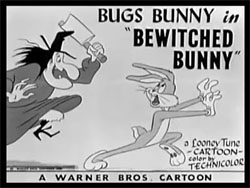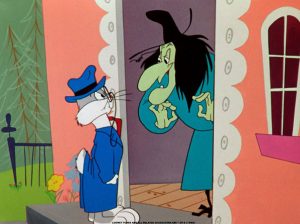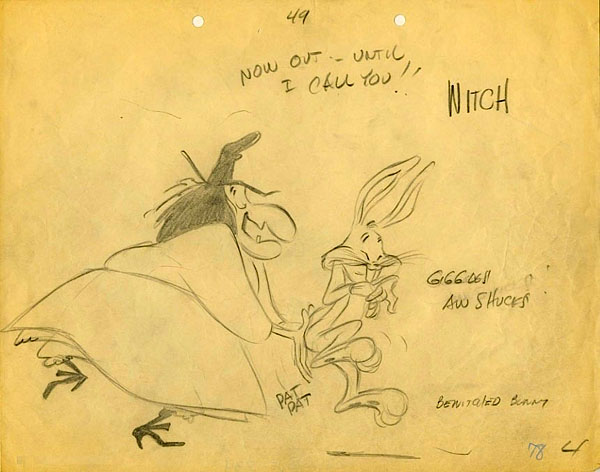
In his book, Chuck Reducks: Drawing from the Fun Side of Life, legendary director Chuck Jones wrote, “Witch Hazel is a vivid example of the fact that beauty is, thankfully, deeper than skin and that outward appearances can, in her case, be trusted.”
The giddy, cackling, and fiendishly funny Witch Hazel made her debut seventy years ago this month in the 1954 Bugs Bunny short subject, Bewitched Bunny. Directed by Jones (billed as Charles M. Jones) with a story by Michael Maltese, animation by Lloyd Vaughn, Ken Harris and Ben Washam, layouts by Maurice Noble, and backgrounds by Philip DeGuard.
 Bewitched Bunny opens with Bugs (voiced by Mel Blanc) walking through the woods reading Hansel and Gretel, when he comes across a house where the story seems to be playing out.
Bewitched Bunny opens with Bugs (voiced by Mel Blanc) walking through the woods reading Hansel and Gretel, when he comes across a house where the story seems to be playing out.
Witch Hazel stands outside, enticing a young boy and girl to come inside by promising them treats (“…I’ll give you candy, ice cream, and pickled herring…”). Bugs intervenes when the two innocent children follow the witch inside the house. “This looks like a job for the masked avenger! But since he ain’t around, I guess I’ll have to take care of it meself,” he says.
Inside, the two children sit in a pot that doubles as a giant ice cream sundae, eating the ice cream while Witch Hazel reads a book of recipes, including “Urchin Pie” and “Kiddie Chops.” There’s a knock at the door, and Bugs comes in disguised as a truant officer. He discovers the kids in the sundae/roasting pan (and also learns that their names are Hansel and Gretel). He tells them to run, and as the children dash out the door, they tell off Witch Hazel, yelling, “Ah! Your mother rides a vacuum cleaner!”
 With the kids gone, Witch Hazel decides to have rabbit stew and turns on Bugs. She comes after him with an ax and a poisoned carrot, which puts Bugs to sleep until he is awakened by the prince who has wandered in from Snow White’s story.
With the kids gone, Witch Hazel decides to have rabbit stew and turns on Bugs. She comes after him with an ax and a poisoned carrot, which puts Bugs to sleep until he is awakened by the prince who has wandered in from Snow White’s story.
Witch Hazel then corners Bugs, who hits her with a magic powder that transforms her into a lovely female Bunny. Bugs takes her arm and walks off with her as the cartoon ends.
The name of the character Witch Hazel came from a skin-cleansing astringent of the same name (derived from the plant of the same name), and Witch Hazel (the character, not the astringent) would go on to appear in other shorts such as Broom-Stick Bunny (1956), A Witch’s Tangled Hare (1959) and A-Haunting We Will Go (1966).
The character also appeared in such other films and TV shows as Bugs Bunny’s Howl-oween Special (1977), Space Jam (1996), and Tiny Toon Adventures.
 One of the many moments of creative animation in Bewitched Bunny is when Witch Hazel darts off-screen and leaves a cluster of hairpins spinning in thin air. In Chuck Reducks, Jones wrote about how this detail became part of the character: “Hazel’s hovering hairpins were in fact a personal statement from me to the penny pinchers at Hanna-Barbera, who would have their characters leave only little linear whorls in the air when they zipped out at speed. I thought that if you were going to leave something, it should be something interesting, like hairpins, or if the bull in Bully For Bugs, horseshoes.”
One of the many moments of creative animation in Bewitched Bunny is when Witch Hazel darts off-screen and leaves a cluster of hairpins spinning in thin air. In Chuck Reducks, Jones wrote about how this detail became part of the character: “Hazel’s hovering hairpins were in fact a personal statement from me to the penny pinchers at Hanna-Barbera, who would have their characters leave only little linear whorls in the air when they zipped out at speed. I thought that if you were going to leave something, it should be something interesting, like hairpins, or if the bull in Bully For Bugs, horseshoes.”
Witch Hazel was voiced in Bewitched Bunny by the talented actress Bea Benederet (the voice of Betty Rubble on The Flintstones and one of the stars of the popular sitcom Petticoat Junction) and later by the legendary June Foray. In her autobiography, Did You Grow Up with Me, Too? (which she wrote with Mark Evanier and Earl Kress), Foray recalled, with fondness, “Chuck Jones turned out to be the perfect director for my kind of voice actor. It’s refreshing and constructive not to be over-directed or to have the guy in charge giving you line readings, performing the copy the way he thinks it should sound, and expecting you to imitate him. Hire the right performer, and you get the right performance. Chuck believed in that. I wish more directors did.”
Foray added, “I did my first line as this Witch Hazel, then waited for Chuck to tell me to do it again – faster, slower, louder, whatever. Instead, to my surprise, he moved on to the next line.
‘Don’t you want me to do it again?’ I asked.
He said, ‘No, that was fine.’
And that’s how it was with Chuck.”

Another animated Witch Hazel would precede the Warner Bros. Witch Hazel. Two years before Bewitched Bunny, Donald Duck starred with Huey, Dewey, and Louie in Disney’s cartoon film Trick or Treat, (which has become a Halloween favorite), that featured a Witch named Hazel.
Disney and Warner’s Witch Hazel don’t look alike, but they share something in common, as Foray provided the voice for both characters. In 1956, Foray voiced another witch, this time for MGM, in the Tom & Jerry short, The Flying Sorceress.
Foray discussed the competing Disney and Warner Witch Hazels in her book, “Since neither studio really owned the name, and people weren’t as litigious as they are today, nothing was said about the duplication of witches. You see, back then, no one really expected the films to be seen much after they played in theaters for a week or two, which was short-sighted in both eyes. They were wonderful cartoons, and they deserved to be seen again and again, by generation after generation.”


 Michael Lyons is a freelance writer, specializing in film, television, and pop culture. He is the author of the book, Drawn to Greatness: Disney’s Animation Renaissance, which chronicles the amazing growth at the Disney animation studio in the 1990s. In addition to Animation Scoop and Cartoon Research, he has contributed to Remind Magazine, Cinefantastique, Animation World Network and Disney Magazine. He also writes a blog, Screen Saver: A Retro Review of TV Shows and Movies of Yesteryear and his interviews with a number of animation legends have been featured in several volumes of the books, Walt’s People. You can visit Michael’s web site Words From Lyons at:
Michael Lyons is a freelance writer, specializing in film, television, and pop culture. He is the author of the book, Drawn to Greatness: Disney’s Animation Renaissance, which chronicles the amazing growth at the Disney animation studio in the 1990s. In addition to Animation Scoop and Cartoon Research, he has contributed to Remind Magazine, Cinefantastique, Animation World Network and Disney Magazine. He also writes a blog, Screen Saver: A Retro Review of TV Shows and Movies of Yesteryear and his interviews with a number of animation legends have been featured in several volumes of the books, Walt’s People. You can visit Michael’s web site Words From Lyons at: 






















Jones’ slam against Hanna-Barbera is a little out of time sequence. It sounds like a comment that may have been made years after the fact when recollections might be a bit blurred. In 1954 William Hanna and Joe Barbera were still crafting the Tom and Jerry theatrical shorts for MGM, and while the budgets were diminishing, the full animation style was still very much in evidence. The reigning kings of the limited animation style in those days (1954) were mainly at UPA which was setting the trend for “less is more” in animation. However, even though the slam might be better directed toward UPA than toward H-B in that era, Jones still makes a valid point about the hairpin gag. And considered retroactively, it could of course be applied to H-B for their later house style from 1957 onward which effectively became the template for television animation.
Hansel?
“Ah, your mother rides a vacuum cleaner!”
Gretel?
I love all the Witch Hazel cartoons, regardless of whether she’s voiced by Bea Benederet or June Foray, and “Bewitched Bunny” is certainly an impressive debut. It always intrigued me that when she transforms into the cute bunny at the end, her hat and nose turn into ears. That sort of morphing only works in silhouette.
In one of her later cartoons — I think it was “Broom-Stick Bunny” — Witch Hazel mentions Paul, her pet Tarantula. We never get to see him, in that or any other cartoon, but I wish we did. There aren’t many cartoon characters named Paul. Offhand, I can’t think of any.
Michael Maltese would return to the Hansel and Gretel story a few years later with the Snooper and Blabber cartoon “Switch Witch”, which reprises the classic line from “Bewitched Bunny”, “Ah, your mother rides a vacuum cleaner!” Much of the cartoon takes place in a courtroom, where Hansel testifies: “She tried to make a smorgas boy out of me!” — “Smorgas Boy”, of course, being one of the recipes in Witch Hazel’s cookbook.
The Jones Witch Hazel is certainly the most memorable. (I even knew a woman, a very sweet one, who looked just like her, only without the green skin and little spindly legs.) His complaint about the Tom and Jerry cartoon, when he’d be making them a decade later, seems almost like a lesson in “If you can’t beat ’em, join ’em.”
Speaking of limited animation, I’d love to know what Jones thought of his “Broomstick Bunny” footage used in the very bad 1966 Daffy-Speedy entry “A Haunting We Will Go,” not quite matched by the new footage of Hazel.
My favorite aspect of this short is the backgrounds, with their flat hyper-stylized graphics. The seemingly painted-on details would appear to be a parody of the UPA aesthetic.
No, I’m sorry, that’s not correct. Charles M. Jones created that “artsy” style of backgrounds as early as 1943, for his cartoon “The Aristo Cat” (the first Hubie and Bertie cartoon. Take a look at it, if you have a chance.
From Jerry Beck’s and Will Friedwald’s 1989 book “Looney Tunes and Merrie Melodies,” p. 142, at the end of the entry for “The Aristo Cat”:
‘Heavily stylized abstract backgrounds highlight this cartoon.”
The cartoon Jones made right after that, “Wackiki Wabbit” (1943), also features that type of abstract backgrounds.
If anything, UPA imitated Jones, not the other way around.
It was actually a trend in graphic arts generally, with roots going back to late-Art Deco and Moderne. By the 1950’s stylization and geometric elements had become the foundation of mid-century graphic design. I don’t think any one person could be said to have invented it. Certainly there were pioneers in using it in animation, but it would have been inevitable in any event.
If we are searching for the beginnings of the UPA aesthetic in cartoons, 1943 is ground zero. Jones with The Aristo-Cat and Waikiki Rabbit, designers Zack Schwartz and Dave Hilberman at Screen Gems on Professor Small and Mister Tall, Willoughby’s Magic Hat (and check the BGs of Way Down Yonder In The Corn). Let’s also remember that Jones teamed with the UPA founders to co-create Hell Bent For Election in 1944.
I stated that the style was being made fun of, not that it originated here.
Back in the 70s this was part of an evening of Chuck Jones animation at UCSC. Bugs’s exit line — “Aren’t they all witches inside?” got a big laugh. Then a few hisses, which triggered a bigger laugh. Biggest laugh of the night was Marc Antony’s sad face near the end of “Feed the Kitty”.
Hansel and Gretel are among my favorite comic bit players. They look funny, sound funny, and move funny while retaining a nice mock cuteness.
That’s awesome. Those are the kind of memorable experiences going to theaters that you just can’t replicate at home, even if you’re watching with a group.
The Donald Duck “Witch Hazel” may have preceded “Bewitched Bunny,” but Terrytoons had a “Witch Hazel” in the Super Mouse cartoon “Pandora’s Box” that came out well before either of them.
Thanks for that! I knew, from some source or other, that there was more than one Witch Hazel, so your entry helps. I had read about the Disney Witch Hazel, but didn’t know about the other one. As early as Super Mouse, huh?
A Haunting We Will Go…what a stinker THAT was! Daffy, Speedy and Witch Hazel all in one vile, magic-free brew.
One of my all time favorite short films! Those German kids are too much!
I have always enjoyed Bewitched Bunny and the Disney Trick or Treat short. I had been wondering how was it that both Warner Bros. and Disney had a character named Witch Hazel. Now I know why!
The final Looney Tunes short aired in Cartoon Network before its’ initial cancellation in 2004, like their equivalent to “False Hare” or “Injun Trouble”. With its ending, they figured kids would be assured Bugs was happy with a girl rabbit, rather than being kicked out in the street after Warner Bros. let him go!